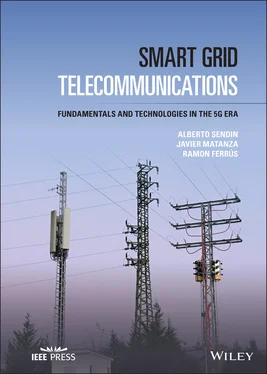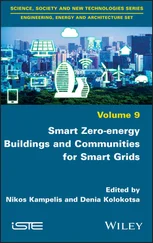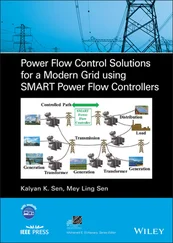Ramon Ferrús - Smart Grid Telecommunications
Здесь есть возможность читать онлайн «Ramon Ferrús - Smart Grid Telecommunications» — ознакомительный отрывок электронной книги совершенно бесплатно, а после прочтения отрывка купить полную версию. В некоторых случаях можно слушать аудио, скачать через торрент в формате fb2 и присутствует краткое содержание. Жанр: unrecognised, на английском языке. Описание произведения, (предисловие) а так же отзывы посетителей доступны на портале библиотеки ЛибКат.
- Название:Smart Grid Telecommunications
- Автор:
- Жанр:
- Год:неизвестен
- ISBN:нет данных
- Рейтинг книги:3 / 5. Голосов: 1
-
Избранное:Добавить в избранное
- Отзывы:
-
Ваша оценка:
- 60
- 1
- 2
- 3
- 4
- 5
Smart Grid Telecommunications: краткое содержание, описание и аннотация
Предлагаем к чтению аннотацию, описание, краткое содержание или предисловие (зависит от того, что написал сам автор книги «Smart Grid Telecommunications»). Если вы не нашли необходимую информацию о книге — напишите в комментариях, мы постараемся отыскать её.
Discover the foundations and main applications of telecommunications to smart grids Smart Grid Telecommunications,
Smart Grid Telecommunications
Smart Grid Telecommunications — читать онлайн ознакомительный отрывок
Ниже представлен текст книги, разбитый по страницам. Система сохранения места последней прочитанной страницы, позволяет с удобством читать онлайн бесплатно книгу «Smart Grid Telecommunications», без необходимости каждый раз заново искать на чём Вы остановились. Поставьте закладку, и сможете в любой момент перейти на страницу, на которой закончили чтение.
Интервал:
Закладка:
Dr Javier Matanza received the M.Sc. in Telecommunication Engineering from the Polytechnic University of Valencia, Valencia, Spain, in 2008, and the Ph.D. degree from Comillas Pontifical University, Madrid, Spain, in 2013. He is currently a Research Professional with the Institute for Research in Technology focused on telecommunication technologies applied to power systems. In addition, he is a lecturer with the Comillas Pontifical University in the areas of Linear Systems, Communication Theory, Advanced Digital Communications on the Bachelor Degree in Engineering and Telecommunications Technologies, Master in Telecommunications Engineering, and Master of Science in Smart Grids; he is also the academic coordinator of the later. He has coauthored 14+ publications in JCR‐indexed peer‐reviewed journals, participated in 29+ international conferences, and worked on 22+ R&D projects. His current interests are in powerline communication technologies, signal processing, and communication network simulations.
Dr Ramon Ferrús received the Telecommunication Engineering (B.S. plus M.S.) and Ph.D. degrees from the Universitat Politècnica de Catalunya (UPC), Barcelona, Spain, in 1996 and 2000, respectively, where he is currently a tenured associate professor within the Signal Theory and Communications department. He has taught in a wide range of basic and specialized courses within the bachelor and master degrees' programs in Telecommunications at UPC, covering topics related to digital communications, data transmission systems, radio communications, satellite communications, mobile communications systems, and network management. At research level, his interests include system design, resource optimization, and network and service management in wireless communications, with his latest activities focusing on the realization of network slicing capabilities in 5G radio access networks and the applicability of data analytics and machine learning techniques for network management. Since 2000, he has participated in 10+ research projects within the 6th, 7 th, and H2020 Research Framework Programmes of the European Commission, taking responsibilities as work package leader in some of them. He has contributed to ETSI standardization activities and is currently involved in 3GPP standardization for the adaptation of IoT‐NB protocols for non‐terrestrial networks. He has also participated in numerous national research projects and technology transfer activities for public and private companies. He is coauthor of two books, three book chapters, and 130+ papers published mostly in IEEE journals and conferences.
Preface
Electric power systems and telecommunications are two of the most basic services supporting our society. Their basic infrastructure nature draws similarities between them, including their high investments needs, their critical nature, and the high expectations over their service quality. However, there are also substantial differences such as the different role that regulation plays in both their technology evolution cycles and the service model.
Electric power systems and telecommunications converge in the Smart Grid concept, as the flagship of a more secure, reliable, resilient, and automated grid, offering a platform to allow a more flexible system model where new power systems technologies and stakeholders may interact, to provide an enhanced electricity service within a more efficient and dynamic power system. Telecommunications are both an enabler of the Smart Grid through the provision of connectivity services to the grid assets, and a system stakeholder that will benefit from this enhanced service.
The grid consists of substations connected with power lines. Substations spread through the territory in which electricity generation is transported and distributed to the customers, across different voltage levels. Transmission and Distribution System Operators rely on their Control Centers to manage electricity service delivery, making use of Information and Communication Technologies, to connect their central and distributed systems' applications, with the grid assets.
Telecommunications networks consist of equipment performing transport, switching, and routing functions over telecommunication media such as optical fiber, radio, and different metallic supporting cables, including power lines; they also integrate ancillary elements and information systems, to create highly resilient telecommunication systems. Telecommunication services are delivered as the final product of Telecommunication systems, and all sorts of end users employ them to remotely communicate people and machines.
Telecommunications have always been instrumental in utility operations. The connectivity to the pervasive and widespread utility assets has always been key to coordinate operation crews and monitor, control and automate the performance of individual grid components and the system as an entity. While trying to leverage commercially provided telecommunication services, utilities have developed private telecommunication networks to fulfill requirements intrinsic to the nature of the grid and the electricity service. On the one hand, environmental conditions and functional performance needs in the grid, vary depending on the underlying infrastructure (Generation, Transmission, Distribution, Point of Supply; substations; power lines; etc.), and a part of them cannot be supported over non‐adapted telecommunication networks and services. On the other, utilities have access to rights of way, physical assets, their own power lines as a telecommunication transmission medium, and electricity. These elements have allowed utilities to build their own telecommunication networks to fully comply with their real‐time mission‐critical needs. These infrastructures and networks have also eventually been used to support telecommunication services by the different fixed and mobile telecommunication systems operators. Thus, a symbiotic relationship exists between both infrastructures, especially relevant when discussing Smart Grids.
The trend in the utility sector is that utilities operate hybrid telecommunication networks. With these networks, utilities provide telecommunication services critical for their power system operation. These networks are hybrid in two aspects. First, they are a combination of private and public (commercial) networks and services, to take benefit from the best of the two domains: private networks can be designed and deployed to fully satisfy requirements, and public services are quick to deploy where requirements fit the needs. Second, different technologies, networks, systems, and telecommunication supporting media (wireline and wireless) are combined, to adapt to the different conditions of the Smart Grid services. All these telecommunications should be managed in an integral way, so that Smart Grid services can be successfully and efficiently deployed and operated.
Electric power systems and Telecommunications are complex functional domains with sophisticated elements that require expert knowledge. The operation of such complex systems increasingly depends on a diverse set of technical aspects and technologies that have usually been the realm of experts, each one in its knowledge field. The complexity of power systems and the complexity of Telecommunications meet and get augmented in the Smart Grid, as the intersection of both. The success in the decision‐making process when designing Smart Grid solutions depends on understanding the details of the underlying technologies and systems, so that the best combination of available solutions can be chosen within the goals and constraints of each Smart Grid vision.
This book has the ambition to provide a comprehensive view of the Smart Grid scenario, together with the Telecommunications that are needed to make it happen. The reader is accompanied in a journey around power systems and telecommunications, reaching Smart Grids. The first part of the journey shows the key general and technical aspects of electric power systems and their service needs in terms of their evolution into the Smart Grid. The second part of the journey shows the fundamentals of Telecommunications; it starts with the high‐level concepts and follows with the lower‐level details of how they are implemented, first at the lower layers of the telecommunication systems, and second in the upper layers' data exchange. The journey stops in several stations, covering the telecommunication systems applicable to Smart Grids, namely optical fiber networks, power line communication (PLC) systems, wireless cellular and wireless IoT systems. Each of these stops offers a selection of example use cases, where the specific group of technologies solves one representative Smart Grid need.
Читать дальшеИнтервал:
Закладка:
Похожие книги на «Smart Grid Telecommunications»
Представляем Вашему вниманию похожие книги на «Smart Grid Telecommunications» списком для выбора. Мы отобрали схожую по названию и смыслу литературу в надежде предоставить читателям больше вариантов отыскать новые, интересные, ещё непрочитанные произведения.
Обсуждение, отзывы о книге «Smart Grid Telecommunications» и просто собственные мнения читателей. Оставьте ваши комментарии, напишите, что Вы думаете о произведении, его смысле или главных героях. Укажите что конкретно понравилось, а что нет, и почему Вы так считаете.












